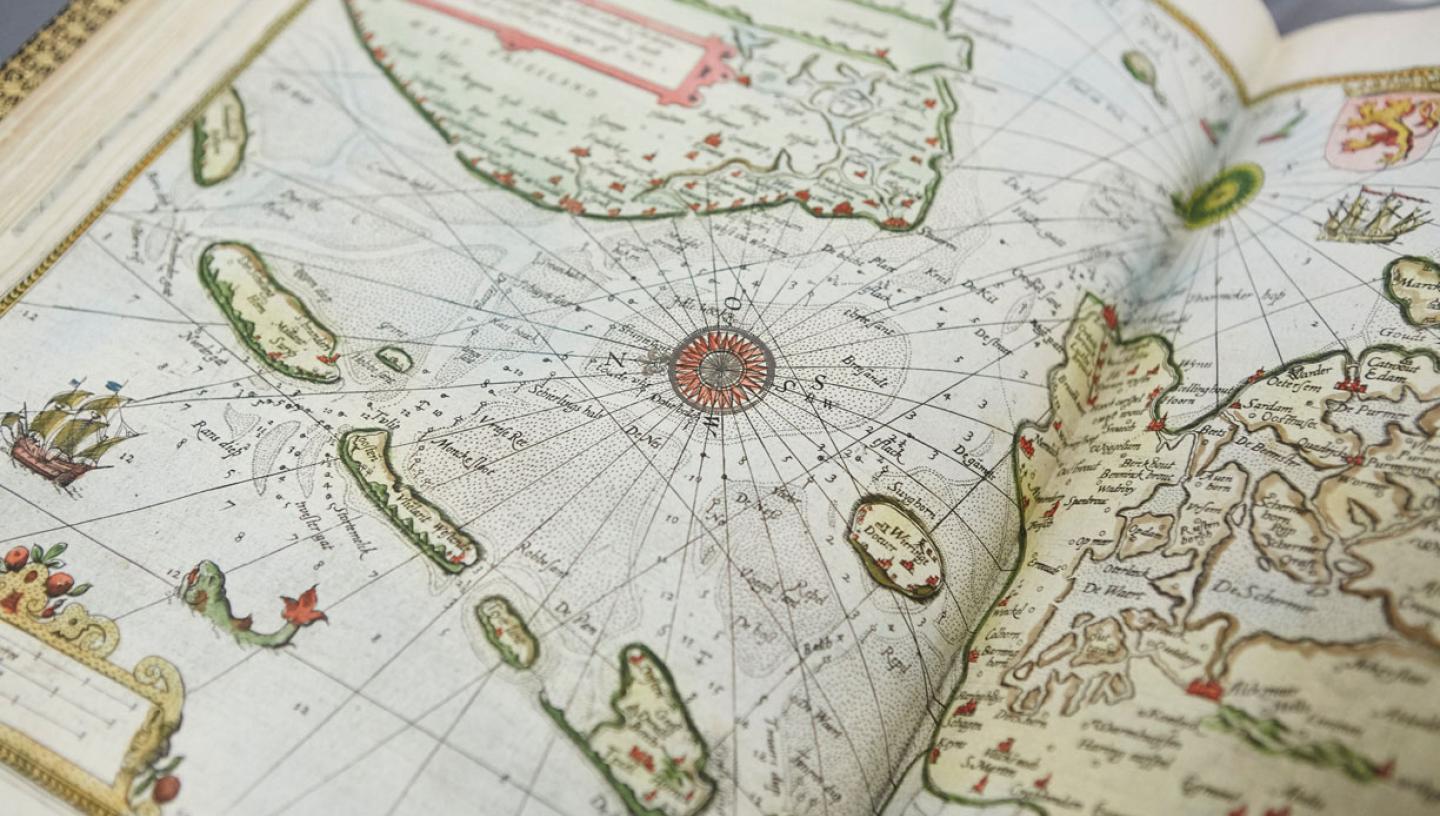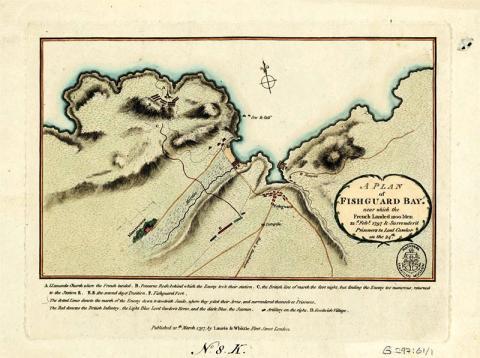
Essential Information
| Location |
National Maritime Museum
|
|---|---|
18 Apr 2011
A small military map of the Battle of Fishguard, which led to the defeat of the last foreign invasion of Britain during the Napoleonic Wars.

Military maps and charts provide the historical researcher with visual evidence of campaigns and battles, and include information such as troop movements, positions and defensive and offensive fortifications.
This small and colourful example produced by Laurie and Whittle in March 1797, features the Battle of Fishguard, which resulted in the defeat of the last foreign invasion of Britain during the Napoleonic War period.
General Lazare Hoche and the newly established Directory (the French revolutionary government), planned an invasion of Ireland with a large army of 15,000 men, in support of Wolfe Tone and his republican movement. At the same time, it was proposed that two smaller landings in northern and southern Britain, would cause national unrest, and hopefully stimulate a patriotic uprising against the British monarchy and ruling classes.
Unfortunately, the French venture was plagued by problems from the outset. The main expedition to Ireland reached its destination, but the anticipated landing was eventually abandoned because of severe weather conditions. The assault on northern Britain was also aborted through troop indiscipline. Surprising, the third incursion proceeded, and a naval force of four warships sailed from Brest on the 18 February 1797, under the command of Commodore Jean-Joseph Castagier. These vessels transported a contingent of troops to the Bristol Channel, with orders to land and sack Bristol, before marching northwards through Wales to secure Chester and Liverpool. Adverse weather and tides prevented the accomplishment of this mission, so the French squadron set course for the south-west coast of Wales. They were twice spotted from the shore as they headed for their new destination of Cardigan Bay.
A French ship entered Fishguard Bay, but withdrew under cannon fire from the local fort and Castagier’s squadron eventually anchored off a small, secluded beach near Llanwnda on 22 February 1797. All through that night and early morning of the next day, men, arms and ammunition were disembarked on Welsh soil, before the naval force departed to join the main French attempt to invade Ireland.
The French army, known as the La Legion Noire (The Black Legion), consisted of 600 regular and 800 irregular soldiers, and included some recently released convicts. They were commanded by Colonel William Tate, an Irish-American veteran of the American Revolutionary conflict. Colonel Tate and his force advanced inland to secure local strongholds, and a military headquarters was established in Trehavel Farm. On 23 February 1797, the invaders were occupying a strong defensive position, on the high rocky ground above Fishguard. However unforeseen trouble began to occur. Although the regular troops were reliable, discipline began to collapse amongst many of the irregular soldiers and convicts, who began to mutiny against their officers and finally deserted to loot and pillage nearby villages and settlements. Several Welsh inhabitants and a small number of French soldiers were killed during brief clashes in the area.
Meanwhile, the British response to the invasion was rapid and constructive. Lieutenant-Colonel Knox, commander of the Fishguard and Newport Volunteer Infantry, raised men in Fishguard, while many local people arrived in the town to reinforce the militia and fight alongside them. In Haverfordwest, Lieutenant-Colonel Colby assembled a small force of around 200 men, who were joined by 150 sailors, from two ships moored in Milford Haven. Elsewhere, John Campbell, 1st Baron Cawdor (c.1757–1821), Captain of the Castlemartin troop of Pembroke Yeomanry Horse and a former Cardigan politician and newly elevated peer, mustered his cavalry at the family seat, Stackpole Court, and with other recruited regional militia units, marched on Haverfordwest.
After establishing the superior strength of the enemy facing him, Lieutenant-Colonel Knox decided against launching an attack as originally intended, evacuated Fishguard and retreated to meet up with Lord Cawdor’s approaching forces at Treffgarne. After a discussion between the two, the peer assumed overall command of the British army, now numbering around 600 men, and led them back in the direction of Fishguard to confront the French situated above the town. Arriving at his destination around late afternoon on 23 February 1797, Lord Cawdor resolved to attack the French positions before nightfall and advanced towards the enemy down a narrow lane. A French grenadier officer descended from the heights with his men. Concealing themselves behind the hedges lining the lane, they prepared to ambush the unsuspecting British soldiers. However, in failing light, Lord Cawdor decided to abandon his plan of action, avoiding a potentially disastrous and high casualty engagement with the foe. He fell back on Fishguard, where he installed his base in the Royal Oak Inn.
Colonel Tate was fully aware of his army’s desperate situation and during the evening of the 23 February dispatched two officers to negotiate a conditional surrender with the British commander. Lord Cawdor rejected the offer and insisted on accepting only an unconditional capitulation by Tate’s men. The French were set a deadline of 22.00 the following morning to make a decision. Failure to consent to this ultimatum would result in a determined attack on the French forces. Early on 24 February 1797, Lord Cawdor lined his men up in battle formation at Goodwick, ready for action to await the French response. Declining to fight and unable to retreat or escape, Colonel Tate had no other options available, and during a meeting with Lord Cawdor at Trehavel Farm was forced to accept the terms of surrender. His soldiers filed down on to Goodwick Sands, where they deposited their arms and weapons and became prisoners of the British, bringing an almost bloodless finale to the venture. The French were paraded through Fishguard on their way to brief confinement in Haverfordwest, but were soon involved in a prisoner exchange and returned to France in 1798.
The victorious Lord Cawdor and Lieutenant-Colonel Knox were congratulated by a relieved nation and also received royal thanks from King George III.
In a final chapter to the disappointing outcome of the French invasion, on 9 March 1797, the Royal Navy frigates, HMS St. Fiorenzo (Captain Sir Harry Burrard Neale) and HMS Nymphe (Captain John Cooke) chased and engaged two ships from Commodore Castagier’s squadron, 10 miles off Brest. The frigate Resistance and corvette Constance were both captured by the British, although Commodore Castagier himself escaped in the frigate Vengeance and successfully reached his home port back in France.
Laurie and Whittle’s map clearly outlines the military manoeuvres that occurred during the two days of the French invasion in February 1797. Using colour coding and a key to identify people and proceedings, the plan provides a fascinating record of events that almost changed the course of British history, back in the last years of the 18th century.
References
- The Royal Navy Day by Day, A. B. Sainsbury and F.L. Phillips, 1979.
- The Last Invasion of Britain, Edwyn Henry Stuart-Jones, 1950.
- Invasion: From the Armada to Hitler, Frank McLynn, 1987.
- Oxford Dictionary of National Biography, 2004.
- The Commissioned Sea Officers of the Royal Navy, 1660–1815, David Syrett and R. L. DiNardo,1994.
- The Complete Peerage, G.E.C. (ed. Vicary Gibbs), 1913.
- Wales For Everyman, H. A. Piehler, 1935.